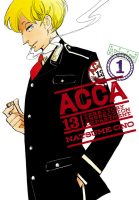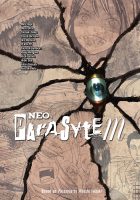My News and Reviews
Last week at Experiments in Manga I announced the winner of the Cache of Kodansha Comics giveaway. The post also includes a list of Kodansha Comics’ manga debuts from 2017. Before the year is over and Experiments in Manga enters retirement I will be holding one last manga giveaway. This week, however, I will be posting the final Bookshelf Overload feature. As for other thing found elsewhere online: Anime Feminist has been posting some really interesting content lately, including but certainly not limited to an interview with Arina Tanemura. Iron Circus Comix recently revealed that it would be releasing Japanese creator Sachiko Kaneoya’s first English-language collection. And speaking of Iron Circus Comix, the publisher’s most recent Kickstarter for Niki Smith’s erotic graphic novel Crossplay may also be of interest. Another Kickstarter project that is worth taking a look at is for the second volume of Minna Sundberg’s fantastic comic Stand Still, Stay Silent. (I enjoyed the first book tremendously.)
Quick Takes
 ACCA: 13-Territory Inspection Department, Volume 1 by Natsume Ono. My first encounter with Ono’s work was through the anime adaptation of House of Five Leaves. After watching it, I immediately sought out the original along with Ono’s other manga available in English. I was very happy when Yen Press announced it would be releasing ACCA (which itself recently received an anime adaptation). The country of Dowa is divided into thirteen separate districts, each of which independently operates a branch of ACCA, a civil service-orientated organization. Jean Otus works for ACCA’s Inspection Department which is always on the alert for and investigates possible corruption within the agency. When the situation demands it, Jean’s colleagues at the office are shown to be quite capable at their jobs, but most of their time seems to be spent bantering over pastries. This does reinforce the perception that the Inspection Department has become superfluous in a time of peace and prosperity, but I also find it to be a delightful bit of characterization. The first volume of ACCA is a slow burn, but it has incredible atmosphere and I enjoyed it greatly.
ACCA: 13-Territory Inspection Department, Volume 1 by Natsume Ono. My first encounter with Ono’s work was through the anime adaptation of House of Five Leaves. After watching it, I immediately sought out the original along with Ono’s other manga available in English. I was very happy when Yen Press announced it would be releasing ACCA (which itself recently received an anime adaptation). The country of Dowa is divided into thirteen separate districts, each of which independently operates a branch of ACCA, a civil service-orientated organization. Jean Otus works for ACCA’s Inspection Department which is always on the alert for and investigates possible corruption within the agency. When the situation demands it, Jean’s colleagues at the office are shown to be quite capable at their jobs, but most of their time seems to be spent bantering over pastries. This does reinforce the perception that the Inspection Department has become superfluous in a time of peace and prosperity, but I also find it to be a delightful bit of characterization. The first volume of ACCA is a slow burn, but it has incredible atmosphere and I enjoyed it greatly.
 Neo-Parasyte M by Various. It’s been a while since I first read it, but I still remember the huge impression that Hitoshi Iwaaki’s horror manga series Parasyte made on me. (I really need to reread it again sometime in the near future.) Last year Kodansha Comics released Neo-Parasyte F, a shoujo/josei anthology created as a tribute to the original Parasyte. It was a fantastic anthology, so I was very excited when its shounen/seinen counterpart (and technically its predecessor) was also licensed. As a whole, I think that Neo-Parasyte F worked better or at least more consistently for me than Neo-Parasyte M, but there are still some terrific stories in the collection. The roster of contributors is rather impressive, too. Of particular note, a piece by Moto Hagio opens the volume. As is to be expected, most of the short manga in the anthology require at least a basic familiarity with Parasyte to be fully appreciated. The twelve stories in Neo-Parastye M take a variety of approaches. Some are more serious while others are more comedic, and a few can even be described as endearing. Not every contribution is successful, but overall Neo-Parasyte M is a great collection.
Neo-Parasyte M by Various. It’s been a while since I first read it, but I still remember the huge impression that Hitoshi Iwaaki’s horror manga series Parasyte made on me. (I really need to reread it again sometime in the near future.) Last year Kodansha Comics released Neo-Parasyte F, a shoujo/josei anthology created as a tribute to the original Parasyte. It was a fantastic anthology, so I was very excited when its shounen/seinen counterpart (and technically its predecessor) was also licensed. As a whole, I think that Neo-Parasyte F worked better or at least more consistently for me than Neo-Parasyte M, but there are still some terrific stories in the collection. The roster of contributors is rather impressive, too. Of particular note, a piece by Moto Hagio opens the volume. As is to be expected, most of the short manga in the anthology require at least a basic familiarity with Parasyte to be fully appreciated. The twelve stories in Neo-Parastye M take a variety of approaches. Some are more serious while others are more comedic, and a few can even be described as endearing. Not every contribution is successful, but overall Neo-Parasyte M is a great collection.

















